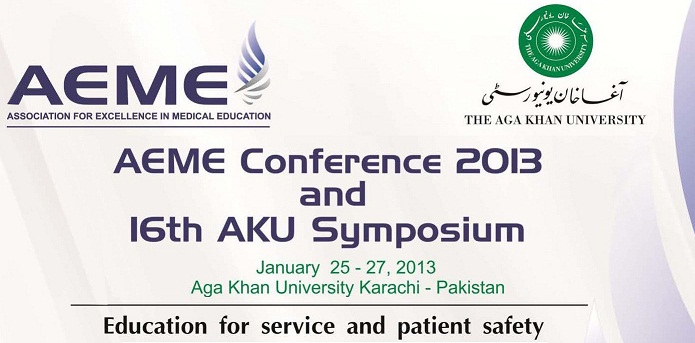Day 2 : Oral Presentations (Theme: Curriculum-Assessment)
Integrated Objective Structured Clinical Examination (OSCE): experience at KIST Medical College,Nepal
Location
AKU Auditorium
Start Date
27-1-2013 9:25 AM
Abstract
Background: Objective Structured Clinical Examination (OSCE) is a reliable approach for assessing basic clinical skills. OSCE was used to assess basic physical examination skills taught to second year undergraduate medical students as a part of early clinical exposure.
Methods: The project was developed to make teaching/learning of physical examination skills structured, involving eight clinical sciences departments and using appropriate methods for teaching and assessment in KIST Medical College, Nepal. The Integrated OSCE method was used for the assessment at the end of completion of posting in all departments i.e. after 28 sessions. Standardized patients (SP) were used for OSCE. SP were healthy individuals from housekeeping department. They were trained to follow students’ commands. A faculty observer at each station used a validated checklist to rate each student’s performance. Feedback about perception of students and faculty were taken on semi structured questionnaire.
Results: Out of 100 students, 98 attended the OSCE. There were 14 OSCE stations; each representing a different system (CVS, Respiratory System, PNS, CNS, Abdomen I & II, Obstetrics, Gynecology, Pediatrics I & II, Musculoskeletal System, General Physical Examination, Eye, and ENT). The mean total OSCE score obtained in each station was 3.77SD+/-0.33 (the maximum score was 5). Eighty percent of the students scored more than 70%. Most (91%) of the students found the OSCE contents from the curriculum, all found SP cooperative, 99% found the overall OSCE environment conducive and 79% found to be satisfied with the setting. All faculty members were satisfied with student\'s approach. Most (92%) of the faculty members found stations setting good to excellent, all expressed satisfaction with the overall management and found cost effective intervention.
Conclusions: Students did well in Integrated OSCE. Students were satisfied with OSCE content, setting and environment. Faculty members were satisfied with approach of students, setting and management and found intervention cost effective.
Key words: Assessment, Integrated OSCE, Physical examination skills
Integrated Objective Structured Clinical Examination (OSCE): experience at KIST Medical College,Nepal
AKU Auditorium
Background: Objective Structured Clinical Examination (OSCE) is a reliable approach for assessing basic clinical skills. OSCE was used to assess basic physical examination skills taught to second year undergraduate medical students as a part of early clinical exposure.
Methods: The project was developed to make teaching/learning of physical examination skills structured, involving eight clinical sciences departments and using appropriate methods for teaching and assessment in KIST Medical College, Nepal. The Integrated OSCE method was used for the assessment at the end of completion of posting in all departments i.e. after 28 sessions. Standardized patients (SP) were used for OSCE. SP were healthy individuals from housekeeping department. They were trained to follow students’ commands. A faculty observer at each station used a validated checklist to rate each student’s performance. Feedback about perception of students and faculty were taken on semi structured questionnaire.
Results: Out of 100 students, 98 attended the OSCE. There were 14 OSCE stations; each representing a different system (CVS, Respiratory System, PNS, CNS, Abdomen I & II, Obstetrics, Gynecology, Pediatrics I & II, Musculoskeletal System, General Physical Examination, Eye, and ENT). The mean total OSCE score obtained in each station was 3.77SD+/-0.33 (the maximum score was 5). Eighty percent of the students scored more than 70%. Most (91%) of the students found the OSCE contents from the curriculum, all found SP cooperative, 99% found the overall OSCE environment conducive and 79% found to be satisfied with the setting. All faculty members were satisfied with student\'s approach. Most (92%) of the faculty members found stations setting good to excellent, all expressed satisfaction with the overall management and found cost effective intervention.
Conclusions: Students did well in Integrated OSCE. Students were satisfied with OSCE content, setting and environment. Faculty members were satisfied with approach of students, setting and management and found intervention cost effective.
Key words: Assessment, Integrated OSCE, Physical examination skills

